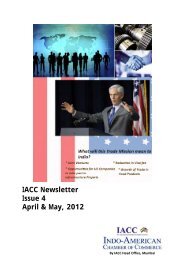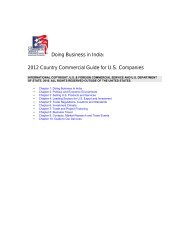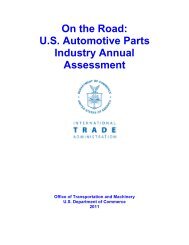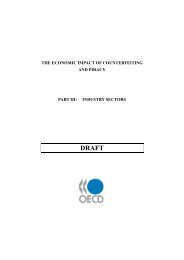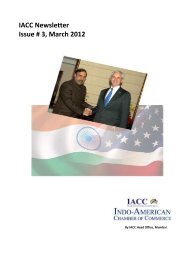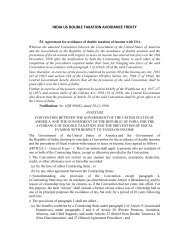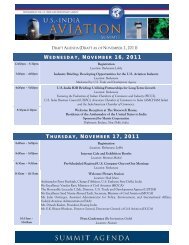Importing into the United States - Indo-American Chamber Of ...
Importing into the United States - Indo-American Chamber Of ...
Importing into the United States - Indo-American Chamber Of ...
Create successful ePaper yourself
Turn your PDF publications into a flip-book with our unique Google optimized e-Paper software.
to <strong>the</strong> seller are dutiable. These proceeds are<br />
added to <strong>the</strong> price actually paid or payable if<br />
not o<strong>the</strong>rwise included.<br />
The price actually paid or payable for <strong>the</strong><br />
imported merchandise is <strong>the</strong> total payment,<br />
excluding international freight, insurance, and<br />
o<strong>the</strong>r c.i.f. charges, that <strong>the</strong> buyer makes to <strong>the</strong><br />
seller. This payment may be direct or indirect.<br />
Some examples of an indirect payment are<br />
when <strong>the</strong> buyer settles all or part of a debt<br />
owed by <strong>the</strong> seller, or when <strong>the</strong> seller reduces<br />
<strong>the</strong> price on a current importation to settle a<br />
debt he owes <strong>the</strong> buyer. Such indirect payments<br />
are part of <strong>the</strong> transaction value.<br />
However, if a buyer performs an activity<br />
on his own account, o<strong>the</strong>r than those which<br />
may be included in <strong>the</strong> transaction value, <strong>the</strong>n<br />
<strong>the</strong> activity is not considered an indirect payment<br />
to <strong>the</strong> seller and is not part of <strong>the</strong> transaction<br />
value. This applies even though <strong>the</strong><br />
buyer’s activity might be regarded as benefiting<br />
<strong>the</strong> seller; for example, advertising.<br />
EXCLUSIONS<br />
The amounts to be excluded from transaction<br />
value are as follows:<br />
■<br />
■<br />
The cost, charges, or expenses incurred for<br />
transportation, insurance, and related services<br />
incident to <strong>the</strong> international shipment<br />
of <strong>the</strong> goods from <strong>the</strong> country of<br />
exportation to <strong>the</strong> place of importation in<br />
<strong>the</strong> <strong>United</strong> <strong>States</strong>.<br />
Any reasonable cost or charges incurred<br />
for:<br />
1. Constructing, erecting, assembling,<br />
maintaining, or providing technical assistance<br />
with respect to <strong>the</strong> goods after<br />
importation <strong>into</strong> <strong>the</strong> <strong>United</strong> <strong>States</strong>, or<br />
2. Transporting <strong>the</strong> goods after importation.<br />
■ The customs duties and o<strong>the</strong>r federal<br />
taxes, including any federal excise tax, for<br />
which sellers in <strong>the</strong> <strong>United</strong> <strong>States</strong> are ordinarily<br />
liable.<br />
NOTE: Foreign inland freight and related<br />
charges in bullet 1 (see part 152, Customs Regulations),<br />
as well as bullets 2 and 3 above, must<br />
be identified separately.<br />
LIMITATIONS<br />
The transaction value of imported merchandise<br />
is <strong>the</strong> appraised value of that merchandise,<br />
provided certain limitations do not<br />
exist. If any of <strong>the</strong>se limitations are present,<br />
<strong>the</strong>n transaction value cannot be used as <strong>the</strong><br />
appraised value, and <strong>the</strong> next basis of value<br />
will be considered. The limitations can be<br />
divided <strong>into</strong> four groups:<br />
■<br />
■<br />
■<br />
Restrictions on <strong>the</strong> disposition or use of<br />
<strong>the</strong> merchandise.<br />
Conditions for which a value cannot be<br />
determined.<br />
Proceeds of any subsequent resale, disposal<br />
or use of <strong>the</strong> merchandise, accruing<br />
to <strong>the</strong> seller, for which an appropriate<br />
adjustment to transaction value cannot be<br />
made.<br />
■ Related-party transactions where <strong>the</strong><br />
transaction value is not acceptable.<br />
The term “acceptable” means that <strong>the</strong> relationship<br />
between <strong>the</strong> buyer and seller did not<br />
influence <strong>the</strong> price actually paid or payable.<br />
Examining <strong>the</strong> circumstances of <strong>the</strong> sale will<br />
help make this determination.<br />
Alternatively, “acceptable” can also mean<br />
that <strong>the</strong> transaction value of <strong>the</strong> imported merchandise<br />
closely approximates one of <strong>the</strong> following<br />
test values, provided <strong>the</strong>se values relate<br />
to merchandise exported to <strong>the</strong> <strong>United</strong> <strong>States</strong> at<br />
or about <strong>the</strong> same time as <strong>the</strong> imported merchandise:<br />
■<br />
The transaction value of identical merchandise<br />
or of similar merchandise in<br />
sales to unrelated buyers in <strong>the</strong> <strong>United</strong><br />
<strong>States</strong>.<br />
■ The deductive value or computed value<br />
for identical merchandise or similar merchandise.<br />
The test values are used for<br />
comparison only; <strong>the</strong>y do not form a substitute<br />
basis of valuation.<br />
In determining whe<strong>the</strong>r <strong>the</strong> transaction<br />
value is close to one of <strong>the</strong> foregoing test<br />
values, an adjustment is made if <strong>the</strong> sales<br />
involved differ in:<br />
■ Commercial levels,<br />
■ Quantity levels,<br />
58 U.S. CUSTOMS SERVICE



